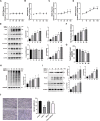Growth differentiation factor 11 induces skeletal muscle atrophy via a STAT3-dependent mechanism in pulmonary arterial hypertension
- PMID: 35524286
- PMCID: PMC9074369
- DOI: 10.1186/s13395-022-00292-x
Growth differentiation factor 11 induces skeletal muscle atrophy via a STAT3-dependent mechanism in pulmonary arterial hypertension
Abstract
Skeletal muscle wasting is a clinically remarkable phenotypic feature of pulmonary arterial hypertension (PAH) that increases the risk of mortality. Growth differentiation factor 11 (GDF11), centrally involved in PAH pathogenesis, has an inhibitory effect on skeletal muscle growth in other conditions. However, whether GDF11 is involved in the pathogenesis of skeletal muscle wasting in PAH remains unknown. We showed that serum GDF11 levels in patients were increased following PAH. Skeletal muscle wasting in the MCT-treated PAH model is accompanied by an increase in circulating GDF11 levels and local catabolic markers (Fbx32, Trim63, Foxo1, and protease activity). In vitro GDF11 activated phosphorylation of STAT3. Antagonizing STAT3, with Stattic, in vitro and in vivo, could partially reverse proteolytic pathways including STAT3/socs3 and iNOS/NO in GDF11-meditated muscle wasting. Our findings demonstrate that GDF11 contributes to muscle wasting and the inhibition of its downstream molecule STAT3 shows promise as a therapeutic intervention by which muscle atrophy may be directly prevented in PAH.
Keywords: GDF11; Pulmonary arterial hypertension; STAT3; Skeletal muscle atrophy.
© 2022. The Author(s).
Conflict of interest statement
The authors declare that they have no competing interests.
Figures







Similar articles
-
Pathophysiological levels of GDF11 activate Smad2/Smad3 signaling and induce muscle atrophy in human iPSC-derived myocytes.Am J Physiol Cell Physiol. 2022 Nov 1;323(5):C1402-C1409. doi: 10.1152/ajpcell.00341.2022. Epub 2022 Sep 12. Am J Physiol Cell Physiol. 2022. PMID: 36094432
-
Therapeutic targeting of GDF11 in muscle atrophy: Insights and strategies.Int J Biol Macromol. 2024 Nov;279(Pt 3):135321. doi: 10.1016/j.ijbiomac.2024.135321. Epub 2024 Sep 3. Int J Biol Macromol. 2024. PMID: 39236952 Review.
-
A GDF11/myostatin inhibitor, GDF11 propeptide-Fc, increases skeletal muscle mass and improves muscle strength in dystrophic mdx mice.Skelet Muscle. 2019 May 27;9(1):16. doi: 10.1186/s13395-019-0197-y. Skelet Muscle. 2019. PMID: 31133057 Free PMC article.
-
DA-Raf and the MEK inhibitor trametinib reverse skeletal myocyte differentiation inhibition or muscle atrophy caused by myostatin and GDF11 through the non-Smad Ras-ERK pathway.J Biochem. 2022 Jan 7;171(1):109-122. doi: 10.1093/jb/mvab116. J Biochem. 2022. PMID: 34676394
-
The role of GDF11 in aging and skeletal muscle, cardiac and bone homeostasis.Crit Rev Biochem Mol Biol. 2019 Apr;54(2):174-183. doi: 10.1080/10409238.2019.1610722. Crit Rev Biochem Mol Biol. 2019. PMID: 31144559 Review.
Cited by
-
Gui-Pi-Tang Defers Skeletal Muscle and Cardiac Muscle Aging by Promoting Mitochondrial Remodeling.Drug Des Devel Ther. 2025 Apr 21;19:3059-3076. doi: 10.2147/DDDT.S509046. eCollection 2025. Drug Des Devel Ther. 2025. PMID: 40291160 Free PMC article.
-
Skeletal Muscle Pathology in Pulmonary Arterial Hypertension and Its Contribution to Exercise Intolerance.J Am Heart Assoc. 2025 Feb 18;14(4):e036952. doi: 10.1161/JAHA.124.036952. Epub 2025 Feb 8. J Am Heart Assoc. 2025. PMID: 39921526 Free PMC article. Review.
-
Impact of Aerobic Training on Transcriptomic Changes in Skeletal Muscle of Rats with Cardiac Cachexia.Int J Mol Sci. 2025 Jul 7;26(13):6525. doi: 10.3390/ijms26136525. Int J Mol Sci. 2025. PMID: 40650303 Free PMC article.
-
Skeletal muscle atrophy in pulmonary arterial hypertension: potential mechanisms and effects of physical exercise.Heart Fail Rev. 2025 Jun 21. doi: 10.1007/s10741-025-10539-6. Online ahead of print. Heart Fail Rev. 2025. PMID: 40542936 Review.
-
Skeletal Muscle Dysfunction in Experimental Pulmonary Hypertension.Int J Mol Sci. 2022 Sep 18;23(18):10912. doi: 10.3390/ijms231810912. Int J Mol Sci. 2022. PMID: 36142826 Free PMC article.
References
Publication types
MeSH terms
Substances
LinkOut - more resources
Full Text Sources
Research Materials
Miscellaneous

